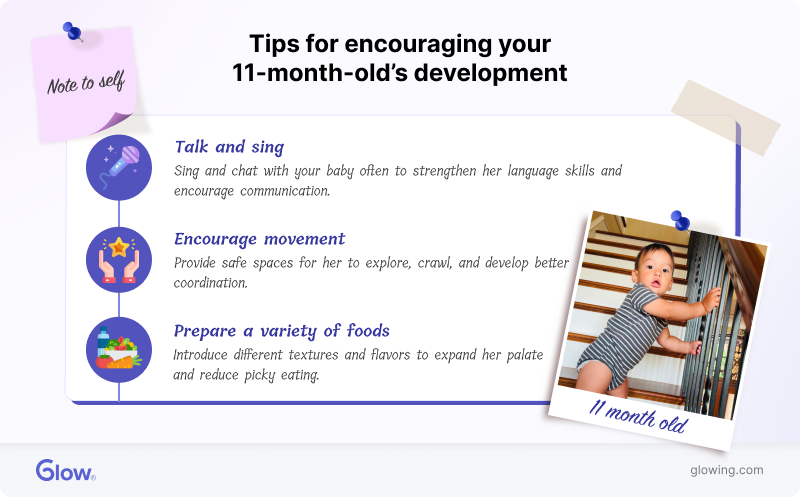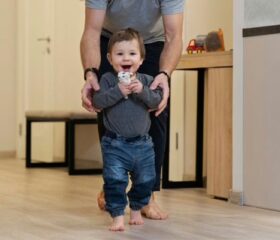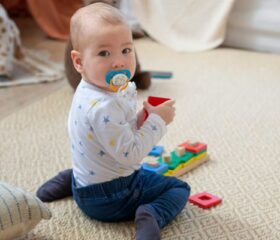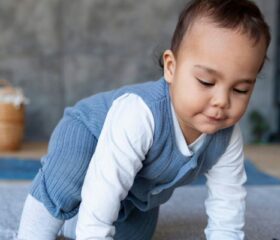Baby Month by Month
11-Month-Old Baby
Your baby can now understand simple instructions.

This will be a busy month for your baby—and for you. Your little one is gaining more independence and taking on the traits of the toddler she’ll soon become. Read on to learn what’s coming in your child’s 11th month and what you can do to be the best parent possible.
What to expect in the 11th month: milestones and new developments
Your baby is getting pretty big, something you’re well aware of if you’ve already started tracking her height with notches on her doorframe. Here’s about how big babies of both sexes usually are by month 11:
- Boys: At this age, boys may be anywhere from 17 to 27 pounds, and most stand 27–32 inches tall. 1
- Girls: As you’d expect, girls tend to be a bit smaller than boys. They tend to weigh 15 to 25 pounds and are often 26–31 inches tall. 2
Those are just averages, and if your baby is a bit smaller (or bigger!) than that, it doesn’t necessarily indicate a problem. That said, if you’re concerned, get in touch with your pediatrician.
Cognitive development
Your baby’s growth isn’t just physical. She’s practicing (and maybe even mastering) new skills, including:
Motor skills
These are probably some of the most obvious developments you’ve seen lately. It’s hard to miss it when your baby starts ramming around on her own.
You may have seen your little one:
- Crawling: Most babies are proficient crawlers by the 11-month-to-1-year mark. They get around using several crawling “styles,” including hands-and-knees, belly crawling, and scooting.
- Stand: If your baby can’t stand on her own yet, she may be using furniture or other fixed objects to pull herself into a standing position.
- Cruising: Once she gets on her feet, your baby may be able to “cruise” by holding onto furniture while she moves.
- Walking: Some early developers even take their first independent steps this month, although most children start walking later, between 12 and 18 months.
- Manipulating objects: Your baby is becoming more adept at using her hands—picking up small objects with a pincer grasp (thumb and forefinger), banging them together, putting them in containers, and letting go intentionally. 3
All of this motor development means your baby is probably able to feed herself, although whether she’s actually willing to do that is another matter entirely. We’ll talk more about feeding time further down in this article.
Communication
Your baby’s taking big mental strides. Again, you’ve probably noticed her exploring the world by touching, throwing, pushing, and banging objects. She’s not just making noise—this is how she learns about concepts like cause and effect. 4
Major cognitive and communicative milestones in the 11th month include:
- First words: Let’s start with the biggest one: you might hear your baby say her first words this month. These will probably be short and simple in the beginning—”mama,” “dada,” “hi,” “bye,” and so on—but it won’t be long until she’s babbling away. 3
- Gestures: Your 11-month-old has probably figured out nonverbal ways of communicating, like pointing, waving, and nodding.
- Comprehension: Your baby understands more than she can say, and she may look at objects when you name them.
- Following instructions: She’s beginning to understand simple instructions, especially when you provide visual cues. If you’re lucky, most of the time, she’ll even follow them.
- Roleplaying: She may be using (or pretending to use) objects in the “correct” way, like pantomiming talking on the phone or drinking from a cup.
All of this is very exciting, of course, but be prepared for it to be tiring, too. After all, your baby’s desire to discover the world is at an all-time high. Get ready for some adventures.
It’s also okay if you find yourself feeling a little sad that the baby days are coming to an end. That’s perfectly normal; just remind yourself that there’s plenty to look forward to.
What should you do if your baby hasn’t hit these milestones?
If your child isn’t talking or walking, don’t worry. Babies develop at different rates, and not all will have reached most of these milestones by their 11th month. The toddler stage is usually when babies start talking, and if yours hasn’t said anything yet, it doesn’t mean she’s lagging behind developmentally—she could just be quiet! However, again, if you’re worried, it’s never a bad move to book an appointment with her doctor to set your mind at ease.
Feeding and sleeping at 11 months old
As your baby approaches her first birthday, her feeding and sleeping patterns are also evolving.
Feeding an 11-month-old
The majority of your baby’s calories should still come from milk or formula. 5 You should be giving her upwards of 24 ounces of it per day, but no more than 32. It’s important for her to transition to solid food, and relying on milk for too long could put her at risk of iron deficiency (anemia).
On that note, in just one more month, you’ll hit another milestone. The one-year mark is when most doctors recommend switching your baby to cow’s milk instead of formula. If you prefer, you can also transition her to another milk alternative, such as fortified soy milk. 6
She may be able to start drinking out of an open cup instead of a sippy cup, too, although it’s a bit early for that transition, and you should expect it to be a several-months-long process.
Moving to solid food
At this stage, your baby is growing more independent, and she’s probably getting adept at self-feeding.
Make sure she eats a wide variety of nutritious foods. For protein (which she’ll need plenty of to support her growth), you can give your baby meat, eggs, tofu, beans, and lentils.
You should also include: 7
- Fruit (such as pears, apples, etc.)
- Vegetables (carrots, broccoli, green beans)
- Healthy grains (oats, brown rice, or quinoa)
- Non-milk dairy products (babies can have pasteurized yogurt or cheese)
Aim for ¼ to ½ of a cup of each per day. For more tailored dietary instructions, check in with your pediatrician.
Take care to avoid common choking hazards like whole grapes, nuts, popcorn, and hard candies. Cut everything you serve your baby into small pieces, and cook veggies until they’re soft.
You’ll probably spend a good chunk of your baby’s 11th month helping her practice her self-feeding technique. Now’s a good time to introduce spoons, although as you’d expect, that will get messy. Consider yourself warned.
Typical sleeping patterns at 11 months
Babies need a lot of sleep, and 11-month-olds are no exception. Yours should be getting between 12 and 16 hours every day. 8
However, while babies start sleeping through the night more reliably at this age, not all of their sleep is at night. At this point in their development, most babies split their sleep into three stretches:
- 11–12 hours in bed at night
- Two naps of 2–3 hours each during the day
What if your baby won’t go to sleep?
Some parents of 11-month-olds find that their babies have trouble sleeping. This can happen for several reasons, including them having a touch of nighttime separation anxiety or just being overly excited from all the exploring they’re doing. 9
To help your baby fall asleep, maintain a consistent (and calm) bedtime routine. Try:
- Giving her a warm bath
- Putting on comfy pajamas
- Singing her a lullaby
- Reading stories (which is also great for her mental development, and could kickstart a lifelong love of reading)
Caring for an 11-month-old baby: health and safety tips
If you’re like most parents, your foremost concern is your baby’s health and safety. Here are a few tips to ensure both:
Toddler-proof your house
You almost certainly baby-proofed your home a long time ago, but now that your little explorer is moving around more, it’s worth revisiting this. You should:
- Secure your furniture (and TVs) to the wall
- Cover any sharp corners with padding
- Do the same with heated radiators or heaters, as long as this doesn’t create a fire hazard
- Install baby gates at the top and bottom of any stairs in your house
- Make sure that cords and other small but dangerous objects are out of reach
- Double-check all of your baby’s toys for choking hazards
Just in case something does happen, you should have a well-stocked first-aid kit at home and know how to use it. This should include a thermometer, bandages, and child-safe pain meds, like ibuprofen and acetaminophen (Tylenol).
Practice proper car and pet safety
Safety isn’t limited to the objects in your home. You also need to pay attention to your car.
Check that your baby’s infant car seat is installed correctly (it should be rear-facing) and that your baby is within its height and weight limits. If you’re using an infant car seat, you’ll probably need to switch to a convertible seat soon.
Supervise your baby around your pets
If you’re a pet parent, too, this advice might disappoint you: you still can’t leave your baby unattended with most pets, including cats and dogs. That’s the case even if your pet is very gentle and you’re sure they’d never bite.
If you plan on letting your 11-month-old interact with your dog at all, make sure they’re well-trained. You should use a baby gate or a crate to create a physical barrier between the two of them when you can’t directly supervise them (even when you’re just a bit distracted).
In addition to keeping your baby safe, creating a little space will probably be a relief to your pet. Think about how tired you get after a few hours of your 11-month-old charging around. Your pet feels that, too!
Pay attention to your baby’s dental care
Baby-proofing your whole environment is a big project, so here’s a smaller one: taking care of your little one’s teeth.
Twice per day, use a soft toothbrush to gently brush them. It’s important to do this even if her teeth haven’t actually come in yet (just brush her gums). Use toothpaste with fluoride, squeezing out an amount that’s about the size of a grain of rice. It won’t hurt her if she swallows this amount, but you should still try to teach her to spit it out as practice.
If she’s teething, she might be uncomfortable. Try giving her:
- Teething toys
- Cold, soothing foods, such as apple sauce
- A damp and cool washcloth to chew (clean it thoroughly and stick it in the fridge)
If she seems like she’s really in pain, you can call your doctor and check whether you can give her mild pain relievers, but only do this at their instruction.
Be careful about what bug repellent you buy
Lastly, here’s another small tip. If you take your baby outside to play (a great idea when the weather’s nice), don’t forget to pack baby-safe bug spray.
When you buy it, watch for these ingredients:
- DEET: This stands for “diethyltoluamide,” a common component in bug repellents. Products consisting of 30% DEET or less are safe to apply to babies.
- Lemon eucalyptus oil: This is another common ingredient. If you see this on the bottle, don’t buy it. Children can only apply bug spray made from this after they’re 3 years old. 10
Note that even if you apply bug spray, it’s still important to check your baby for ticks once she’s done outside.
Should you plan on a doctor visit this month?
You probably don’t have a well-baby visit scheduled this month, and unless your child gets sick or there’s something worrying you, you don’t need one.
Of course, that goes out the window if she does come down with something or still has a lingering issue that should have resolved already, such as baby acne or cradle cap (flaky scalp). Don’t panic, but get her to the doctor.

More tips for encouraging your 11-month-old’s development
Alongside keeping your kid safe, you’re probably also concerned with helping her reach those important 11-month milestones we keep talking about. Here’s what you can do to give her a boost:
- Talk and sing: Sing to your baby and engage with her in back-and-forth conversations. This will do a lot for her language development.
- Encourage movement: Create safe spaces for your baby to explore, both indoors and out.
- Prepare a variety of foods: Introduce new textures and tastes to your baby as she becomes more confident and adventurous. This won’t just stimulate her mind, it will also make her less likely to turn into a picky eater later on.
As you’ve probably noticed, most of these tips boil down to “create a stimulating environment for your baby.” Unsurprisingly, this is one of the most important things you can do for her development.
Final thoughts
Just to reiterate, every child grows at her own pace, and if your baby doesn’t quite match the picture we’ve painted in this article, that doesn’t necessarily mean there’s a problem. However, if you’re concerned or just want a little more advice on how to help her hit her 11-month milestones, reach out to your pediatrician.
On another note, try not to get so wrapped up in the day-to-day of caring for your baby that you forget to enjoy this period, too. Do your best to relax, and take lots of pictures. Your little one is transitioning from a baby to a toddler, and the next few months are going to be full of adventures you’ll remember for the rest of your life.
Article Sources
- U.S. Centers for Disease Control and Prevention. "Birth to 36 months: Boys, Length-for-age and Weight-for-age percentiles" Retrieved July 17, 2025.
- U.S. Centers for Disease Control and Prevention. "Birth to 36 months: Girls, Length-for-age and Weight-for-age percentiles" Retrieved July 17, 2025.
- U.S. Centers for Disease Control and Prevention. "Important Milestones: Your Child By One Year" Retrieved July 17, 2025.
- Journal of Experimental Child Psychology. "Learning to make things happen: Infants' observational learning of social and physical causal events" Retrieved July 17, 2025.
- Geneva: World Health Organization; 2009.. "Infant and Young Child Feeding: Model Chapter for Textbooks for Medical Students and Allied Health Professionals" Retrieved July 17, 2025.
- U.S. Centers for Disease Control and Prevention. "Cow's Milk and Milk Alternatives" Retrieved July 17, 2025.
- U.S. Centers for Disease Control and Prevention. "When, What, and How to Introduce Solid Foods" Retrieved July 17, 2025.
- National Heart, Lung, and Blood Institute (NHLBI). "How Much Sleep Is Enough?" Retrieved July 17, 2025.
- MedlinePlus. "Bedtime habits for infants and children" Retrieved July 17, 2025.
- U.S. Centers for Disease Control and Prevention. "Insect Repellents Help Prevent Malaria and Other Diseases Spread by Mosquitoes" Retrieved July 17, 2025.







